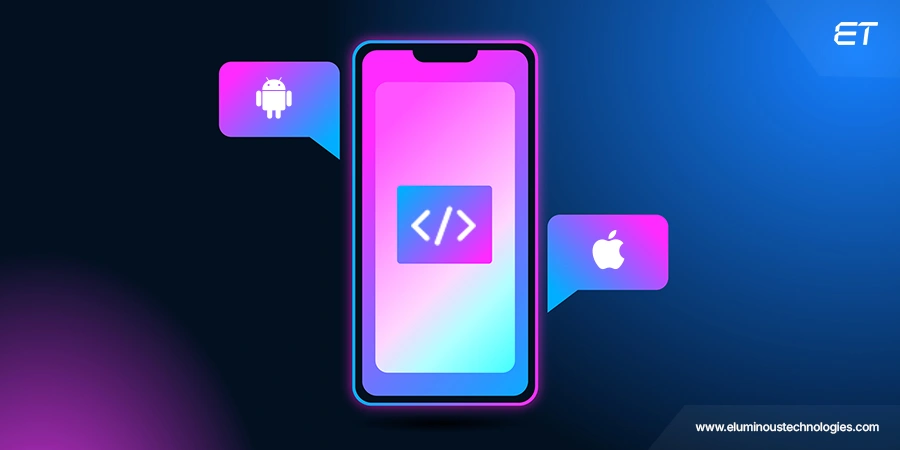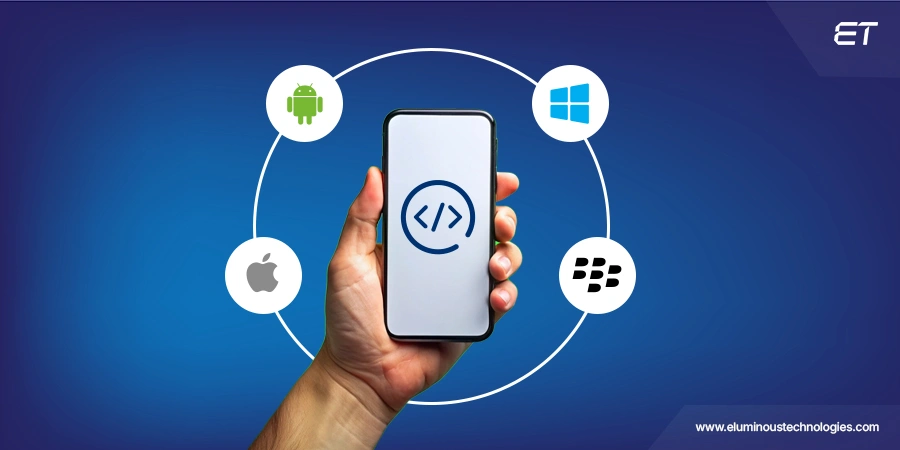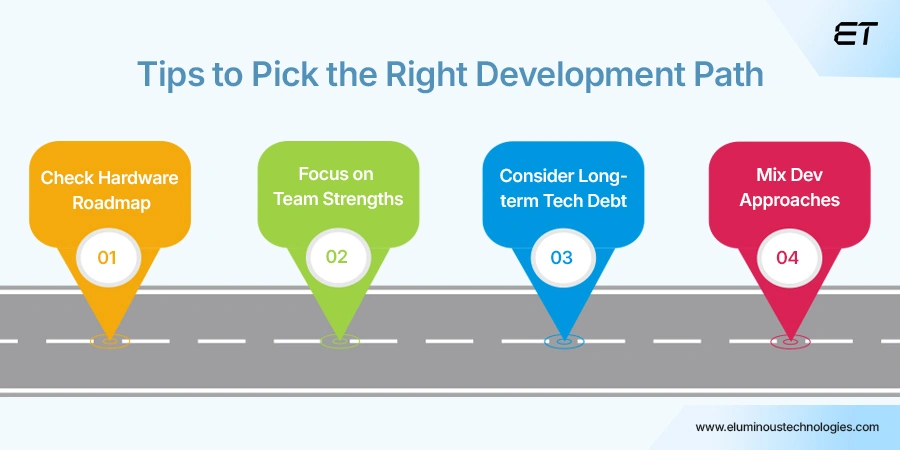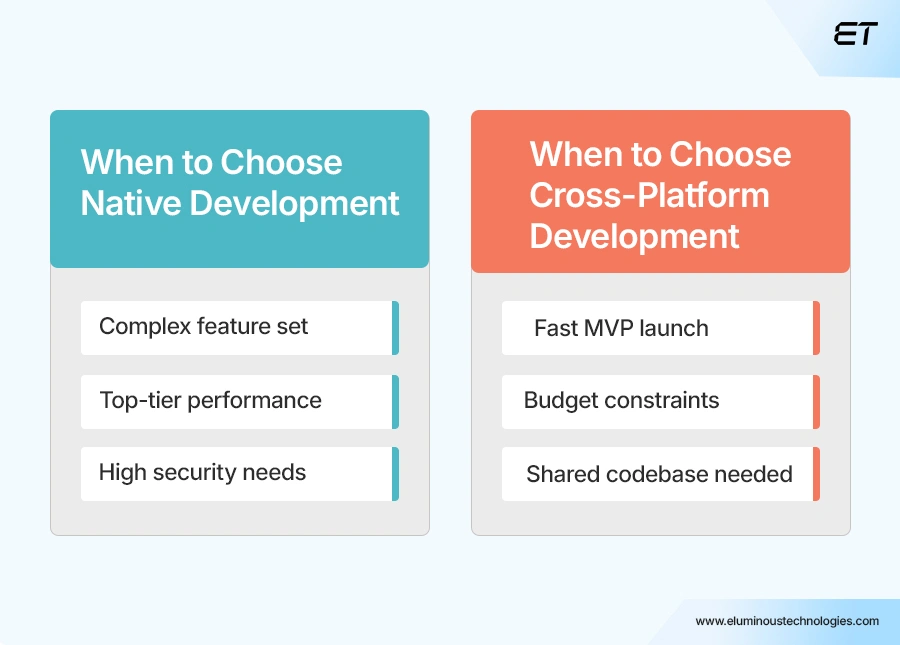
Native vs Cross Platform: A Complete Breakdown for Tech Leaders
- Comparing native vs cross platform development is necessary for project success.
- Native offers better performance and tighter OS integration.
- Cross-platform enables faster rollouts with a shared codebase.
- UI customization is more precise and fluid in native development.
- Cross-platform suits MVPs or startups needing quick iteration.
Do you have a mobile app idea with the potential to disrupt your market?
You can’t go all-in with the development. You need to consider the platform where your target customers reside. This means the biggest hurdle early on will be choosing between native vs cross platform development.
Native development offers platform-specific advantages and top-tier performance, while cross-platform approaches bring speed and cost-efficiency. Each path has its strengths, trade-offs, and use cases.
This guide compares native and cross platform development head-to-head, along with their pros and cons. We’ll also discuss actionable criteria to pick the right dev path that fits your goals.
It’s time to think, plan, and build smarter.
Need help choosing the right dev method?
Native vs Cross Platform: A Quick Glance at the Core Differences
Before getting into the nitty-gritty of native vs cross platform development, here’s a quick rundown of what sets them apart.
| Factor | Native Development | Cross-Platform Development |
| 1. Target Audience |
|
|
| 2. Development Time |
|
|
| 3. App Complexity |
|
|
| 4. App Development Cost |
|
|
| 5. Security Considerations |
|
|
| 6. UI/UX Flexibility |
|
|
| 7. Scalability |
|
|
What is Native App Development?

Let’s start with the core fundamentals of native vs cross platform.
Native app development is the approach of building an app for users of a particular platform, like iOS or Android. For iOS, developers typically use Swift or Objective-C with Xcode; for Android, it’s Kotlin or Java with Android Studio.
These apps are fully optimized for their respective platforms, offering peak performance, security, and user experience.
If you’re planning to choose native development, here are the benefits you’ll receive:
- Great Performance – Native apps utilize the device’s full hardware capabilities, like the GPU, sensors, and camera, for smoother performance.
- Scalability – Native frameworks are better suited for complex, long-term projects where performance and consistency are non-negotiable.
- Security – Platform-level security protocols are easier to implement and maintain in native environments.
- Tighter OS Integration – Direct access to platform-specific APIs allows better customization and a fluid user experience.
However, there are certain drawbacks to this dev strategy you need to consider:
- Additional Staff Requirement – Native projects often demand platform-specific developers, stretching your team size and hiring budget.
- Slower Iteration Cycles – App feature updates require duplication and syncing across both platforms, which delays deployments.
- Higher Development Cost – Maintaining separate codebases for individual platforms requires more resources and budget.
- Longer Time-To-Market – Building and maintaining apps for separate platforms increases development timelines.
Managing dual-platform teams demands rigorous coordination.
Example
A ride-booking app like Uber relies on native development for real-time GPS tracking, push notifications, and smooth map rendering, all of which demand tight integration with device hardware and zero performance compromises.
What is Cross Platform App Development?

When exploring native vs cross platform strategies, align your decisions with core business objectives—like time-to-market and user reach.
To reach customers across multiple platforms, cross platform development is the way to go. These apps seamlessly run on iOS and Android, via a shared codebase.
Tools like Flutter, React Native, and Xamarin allow developers to write code once and deploy it across devices. It reduces development time and effort.
- Easier Maintenance – Single updates and bug fixes reduce complexity and improve release speed. Debugging and testing are also convenient this way.
- Cost-effective – Reduces the need for separate iOS and Android teams, lowering overall development costs.
- Consistent User Experience – A single UI design across platforms maintains brand consistency and experience.
- Faster Deployment – Launch apps faster and reduce overhead without sacrificing quality. Perfect for MVPs and pilots.
Just like any development strategy, there are some cons you can’t ignore:
- Dependency on Third-Party Tools – App quality often relies on external frameworks and their ongoing support.
- Limited Device Feature Access – These apps may struggle to fully access certain native APIs or hardware features, limiting performance.
- Larger App Size – This development process can increase the overall app size compared to native builds.
- Slower Updates – Cross-platform frameworks often delay access to new OS features until their own updates are released.
Cross-platform is ideal for time-sensitive projects where speed, reach, and cost-efficiency outweigh the need for platform-deep performance.
Example
Imagine a healthtech startup building an MVP for a fitness tracking app. Using React Native, they launch simultaneously on Android and iOS, reaching a broader user base early. The process also reduces the development timeline.
Searching for top React Native agencies?
Native vs Cross Platform Face-Off: Unpacking 7 Key Differences
Ready to settle the native vs cross platform debate? Here are seven core differences to understand how the development methods vary.
1. Target Audience

The first cross platform vs native development comparison factor is the target customers.
Native apps are ideal for targeting platform-specific user bases with distinct requirements:
- Ideal for customers expecting fast, seamless, and responsive app interactions.
- Users handling sensitive data like banking, healthcare, or government services.
- Perfect for users relying on advanced features like biometrics or real-time GPS tracking.
So, if market research shows that your premium users are iOS-based, follow a native approach.
On the contrary, cross platform apps have a broader market with diverse customer groups:
- Ideal for customers focused on accessing information, media, or e-commerce rather than heavy device interaction. (Think Instagram or Amazon)
- Users who prioritize functionality and usability over platform-specific aesthetics like stylish navigation bars or on-click animations.
Corporate professionals who need standardized features across various devices for productivity also prefer cross platform apps.
The Bottom Line
Choose native development for performance-driven users. Cross platform development is suitable for reaching customers who emphasize usability and multiplatform accessibility.
2. Development Time

The next native vs cross platform distinction is the app development time, as it impacts time-to-market strategies and project timelines.
Building native apps typically takes more time, especially when building for both iOS and Android:
- Each platform needs its own dedicated codebase, tooling, and testing cycle.
- Keeping app features consistent on individual platforms is time-consuming.
- Bug fixes and updates require separate implementation, doubling quality assurance efforts.
These factors automatically slow down the app’s time-to-market. But, if you opt for cross platform development, teams receive these time advantages:
- A shared codebase allows convenient deployment across platforms with faster development cycles.
- Teams can reuse UI and logic components, boosting development time.
- Frameworks like React Native support hot reloads, letting developers see code changes instantly.
Here, the approach accelerates dev cycles and reduces dev-test-feedback loops.
The Bottom Line
Cross-platform dev is ideal if speed, early market entry, or quick user feedback is key. If platform-optimized user experience and long-term growth are a must, choose native development.
3. App Complexity

Is your application feature-rich and needs heavy processing? Or is it lightweight and minimalist?
Figuring out these answers will define your app’s complexity, an important native vs cross platform point of comparison.
Native software development involves platform-dependent functionalities, making the app complex:
- The apps require access to low-level APIs to offer features like real-time video processing or augmented reality.
- Complex background tasks such as push notifications or offline data syncs.
- Apps need deep integration with system-level features like health data or custom gestures.
As complexity increases, the project timelines also extend. In contrast, cross platform apps are less complicated and faster to build:
- Often called modular apps, they consist of smaller parts or modules that work independently and are reusable.
- Ideal for content-based apps, e-commerce marketplaces, or internal tools with simple workflows and limited hardware interaction.
- Easier to update and maintain when teams need to enhance app features.
Plugins and libraries add features easily, but might not support custom app requirements like GPS tracking or secure payments.
The Bottom Line
For feature-rich, high-performance apps, native is ideal. Cross-platform suits simpler apps needing faster delivery and broader reach.
4. App Development Cost

The expenses of cross platform app development vs native impact overall budget, tools, and maintenance requirements.
As per a market study, building a simple or cross platform app costs between USD 5,000 and USD 50,000. A native or complex app dev budget falls between USD 50,000 and USD 300,000.
But why is there a significant difference? Let’s find out.
Native development is more expensive upfront, particularly when building for both iOS and Android:
- Requires two separate teams or developers with specialized skills for each platform.
- Teams need to design, develop, test, and maintain the app separately across platforms.
- Licensing tools, SDKs, and third-party services for each OS can increase operational costs.
Cross platform apps, on the other hand, offer better cost efficiency due to these reasons:
- A single team using one codebase reduces hiring and resource requirements.
- Shared UI components and business logic lower design expenses.
- Ongoing updates and fixes are faster and cheaper with centralized code management.
However, long-term cost depends on app complexity and scale. Native apps may cost more initially, but often deliver better ROI for advanced products.
The Bottom Line
Cross-platform is cost-efficient for simple or early-stage apps. Choose native when performance or complexity demands outweigh initial savings.
Uncover real app dev costs before building
5. Security Considerations

The ideal development strategy must offer maximum data protection and prevent breaches. So, assessing the security features of native vs cross platform dev methods becomes non-negotiable.
Let’s start with native development, which offers greater control and tighter OS-level security integration:
- Direct access to platform-specific security features like biometric authentication, secure storage, and encryption APIs.
- The approach aligns better with security updates, patches, and compliance protocols.
- Doesn’t rely too much on third-party abstractions, reducing vulnerabilities that attackers can exploit.
However, for cross platform applications, security features are limited:
- These apps often rely on plugins that may not access full native protection features.
- Cross-platform tools may lag behind OS updates, briefly leaving apps without the latest security features.
- Handling secure storage or login may need additional coding, making the app more complex and risky.
This extra cross platform code for secure tasks increases the risk of errors, exposing the app to vulnerabilities.
The Bottom Line
Opt for native development for high-security apps. Cross-platform can work, but may require extra layers and effort to ensure protection.
6. UI/UX Customization Flexibility

Your design team needs room to customize the app to meet users’ needs and keep them hooked. That’s why UX customization flexibility is a prime factor when evaluating native vs cross platform methods.
Native development offers full access to platform-specific design components and interactions:
- Developers can follow the exact iOS (Human Interface Guidelines) and Android (Material Design) standards.
- Advanced animations, transitions, and gesture-based navigation are easier to implement natively.
- Native apps can immediately adopt new UI components introduced in iOS or Android updates.
Even though cross-platform frameworks provide a consistent design across devices, keep these points in mind:
- Platform-specific nuances (like navigation behavior or font rendering) can be harder to recreate.
- UI libraries help, but for advanced design changes, additional native code is needed.
- Certain built-in design features, like iOS’s blur effects, aren’t available in cross-platform tools, so developers must rebuild them.
However, designers can enjoy easier updates with a shared codebase and component libraries.
The Bottom Line
Choose native for top-notch platform-optimized UI. Cross-platform works well for standardized designs with moderate customization needs.
7. Scalability

The last aspect for comparing native vs cross platform development is how scalable the app can be over time. Scalability impacts how your app features evolve as per platform demands and user requirements.
For complicated apps, native development is well-suited due to these benefits:
- Ideal for integrating new platform-specific features without waiting for framework updates.
- It allows different parts of the app to update separately without affecting the whole system.
- Platform-native tools make it easier to manage infrastructure and monitor performance.
In contrast, cross platform dev is appropriate for simple apps with a modular architecture:
- Managing a single codebase is easier when the app expands across markets or user types.
- Ideal for adding features rapidly, especially when business logic is centralized.
- Scaling updates across platforms is faster, reducing release cycles and operational overhead.
Platform-specific optimizations for cross platform apps may need custom development/coding.
The Bottom Line
Opt for native development to scale complex, performance-driven apps. Cross-platform scales efficiently for simpler, content-rich, or modular apps.
Want a stronger team to scale your app?
Native vs Cross-Platform: 5 Smart Tips to Pick the Right Dev Path

Before committing to a development strategy, ensure the decision aligns with long-term goals. Here are some practical tips to choose wisely.
- Check Your Hardware Roadmap: If your app will use features like AR (Augmented Reality) or biometrics, go native. Platform-specific SDKs support these features conveniently.
- Focus on the Team Strengths: If your devs already excel in Swift or Kotlin, native ensures faster execution. Avoid delaying timelines by forcing teams to learn a new framework.
- Consider Long-term Tech Debt: Cross-platform speeds up MVPs, but it can struggle at scale. Choose an architecture that can evolve without accruing long-term inefficiencies.
- Mix Dev Approaches If Needed: Begin with cross-platform for speed, and rebuild natively when scale or speed becomes crucial.
Always analyze the project requirements and customer needs before choosing a development style.
Native vs Cross-Platform: The Final Verdict

There’s no one-size-fits-all solution to app development.
It all boils down to your app’s goals, complexity, audience, and team strengths.
Native development offers unmatched performance and access to platform-specific features, making it ideal for apps needing hardware integration or scalability. Cross-platform frameworks provide faster time-to-market and lower upfront costs, suitable for startups or internal tools.
Ultimately, weigh the cross-platform vs native options carefully, keeping business objectives in mind. Don’t hesitate to use a hybrid strategy when the situation calls for it.
Choose your ideal build path with expert clarity.
Frequently Asked Questions
1. What is native vs cross platform?
Native apps are built separately for iOS and Android. Cross-platform apps share a single codebase on both platforms.
2. Is Spotify native or cross-platform?
Spotify primarily uses native development for performance. It also uses some cross-platform tech like React Native for selected features and UI consistency.
3. How does platform-specific hardware integration differ between native vs cross platform development?
Native apps access hardware features directly, enabling better performance. Cross-platform tools often need third-party plugins or conditional code blocks to access hardware, which adds complexity and may limit access.





